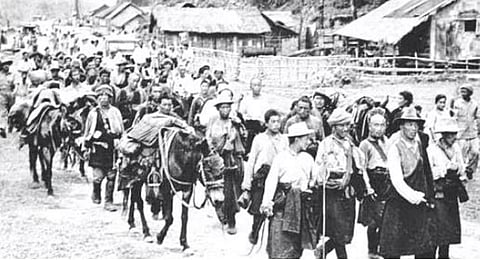

In October 1950, the Chinese People’s Liberation Army invaded the Tibetan region of Chamdo, beginning the start of what has been—and continues to be—one of the most heart-breaking stories of exile ever. Within a decade of the Chinese invasion of Tibet, the 14th Dalai Lama was forced to flee Tibet: in March 1959, he took asylum in India. Besides the spiritual leader’s retinue that went into voluntary exile with him, so did thousands of other Tibetans, all leaving behind homes, stability, memories.
Tsering Yangzhom Lama’s We Measure the Earth with Our Bodies begins in this time, this space, as a small family—father, mother, their two young daughters—leave their home in a Tibetan village and set out for Nepal. The elder daughter Lhamo, not yet a teenager, ends up taking on perhaps more than her fair share of work as her mother, who is the local oracle, finds the best path for the village to follow––the safest, the most likely to bring them to a land where they will find peace and prosperity.
But will they? Can the Tibetans, ousted from their homeland, ever really settle down elsewhere? This is a question that crops up again and again in subtle ways all through Lama’s novel as it moves across 50 years and two continents. Divided into three parts, the book is always told in the first person, but the narrators change. In part 1, ‘Daughters’, the narrators are Lhamo in the early 1960s and her daughter Dolma, 50 years later in Canada. In part 2, ‘Sisters’, Lhamo and her sister Tenkyi continue the story, bridging the gap between Nepal (where Lhamo still lives) and Canada (where Tenkyi now lives with her niece Dolma). The last part, ‘Lovers’, is told from the point of view of Lhamo and Samphel, the man whom she first came to know as a young teenager in a refugee camp in Nepal.
Thrown into the mix is a sacred artefact, a tiny statue made of mudstone, a ku, which finds its way into Lhamo’s family. The ‘Nameless Saint’, as he is known and venerated by Lhamo’s friends and family, is believed to have the power to make his way wherever he is most needed. How he travels, whether of his own accord or pushed and pulled by the humans around him, forms an important thread in this tale.
While there are plenty of other characters—friends, relatives, lovers, teachers—it is these four people, their lives intertwined, who form the core of the novel: Lhamo, Tenkyi, Samphel and Dolma. In their attempts to rebuild lives torn apart by displacement, their ache for stability, prosperity and love, the dreams that haunt them and the memories that pull them back towards a land that is no longer their own, they are very real, complex and three-dimensional.
They, perhaps, are also, symbolic of the Tibetans in general: a people in exile, permanently moving, ‘measuring the Earth with their bodies’. As Lama explains it, through the words of Dolma: “Of course,
I knew about prostrations…
I remember the story of one pilgrim who had even travelled across all of Tibet, from east to west, lying down and rising, over and over until he reached the yearly Kalachakra prayers in India.” For Dolma herself, and for Tenkyi and Samphel, to some extent, there is a need to travel in order to find truth and solace—if not for themselves, for those they care for—that is almost akin to the deep devotion needed for prostrations. Perhaps that is true for most Tibetans, suggests Lama––searching constantly, traversing the globe, trying to find a way back.
Not only is We Measure the Earth with Our Bodies deeply moving, it also serves to show something of the ethos of the Tibetan diaspora. These are a people who have been displaced for so long and forgotten. No foreign powers battle on their behalf, and they are overlooked when it comes to the global memory of human rights. Protests, petitions, self-immolations and more get swept away with the debris of everyday news, leaving little or no mark of their passage. Painfully, few people outside of the Tibetan community know or value anything about them, other than their culture––those beautiful thangkas, the exquisite arts and crafts and the Tibetan chants.
But what lies beneath it all?
This novel serves to explain some of that in a gentle, sympathetic way that is very readable and at the same time informative. Never, however, does the information seem like it’s been shoehorned into the narrative. It’s organic, flowing naturally to build up a story of people living, loving, dreaming—and perhaps someday returning, circling back to where they belong.
We Measure the Earth with Our Bodies
By: Tsering Yangzom Lama
Publisher: Bloomsbury
Pages: 350
Price: Rs 699